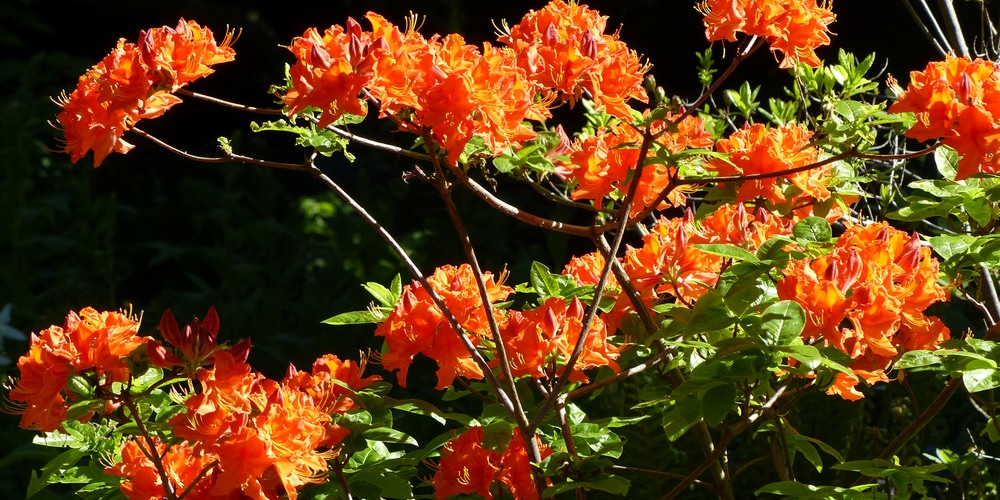‘Are Azaleas cold hardy?’ The question usually comes up for those who are interested in growing azaleas in their garden. This is also a concern for plant enthusiasts living in colder climates and regions.
Truth be told, there are dozens of different species to discover when looking for an azalea to plant in cold zones. Generally, azaleas prefer a mild climate but there are cold-hardy varieties that can withstand frost temperatures of up to minus 45 degrees F. This puts them as viable plants to grow in USDA zones 4, or even 3.
What Temperatures Can Azaleas Take?

Azalea plants prefer to grow in environments with temperatures ranging from 0 degrees to 90 degrees F. In the growing season and while blooming, the preferred temperature is at least 32 degrees F or higher.
If you live in zone 4 or regions that get freezing in the winter, then the best course of action is to plant cold-hardy azalea varieties. In general, evergreen azalea species have a lower frost tolerance compared to their deciduous cousins.
Most azaleas can only take up to minus 5 degrees F before it damages their new flower buds or leaves.
However, there are exceptionally cold hardy varieties you can consider, such as those that belong in the hybrid species, particularly the Northern Lights species and the Roseshell azalea, for example.
How Cold is Too Cold for Azaleas?
It’s established that most azaleas can survive temperatures between 0 to minus 5 degrees F, while there are some that can withstand frost of up to minus 35 or even minus 45 degrees F. This depends on the variety and whether they’re hybrid, evergreen, or deciduous.
Deciduous azaleas can take cold temperatures as low as minus 35 degrees F. If exposed to freezing temperatures they can’t take, azaleas will start by dropping new leaf growth and flower buds.
Deciduous azalea species will either start shedding their leaves or exhibit leaf curl or droop when the temperature reaches 32 degrees F and lower.
Aside from USDA zones, several other factors come into play when protecting azaleas from frost and constant freezes. Those exposed to wind or frost pockets are more likely to suffer frost damage compared to azalea plants that have a windbreak, e.g., a wall or a taller structure. Mulching can also help, as is covering with plastic sheets and similar material.
Site selection is important for those who wish to grow azaleas in their yard or garden. A healthy plant is less likely to succumb to stress, and if you meet an azalea’s growing requirement then you can look forward to lush leaves and plenty of blooms from spring to summer.
Remember, azaleas prefer to stay in dappled sun locations, or areas that get partial sunlight. More than that, their soil should contain plenty of rich organic matter and should be well-draining. Regular watering is also a must, especially if you put your azaleas in full sun and during hot summer days.
Azalea Cold Hardiness Zones
Most azalea varieties grow in USDA zones 4 through 9. However, there are some species that can tolerate frost in zone 3 areas (up to minus 45 degrees F).
The key to successfully growing azaleas in your zone is to choose the right variety from the start. The good news is that there are dozens of different azalea plants, with each one having its foliage feature and blooming characteristics.
If your area is known to experience freezing temperatures and brutal winters, then you should pick a cold-hardy azalea species that will do well in your environment. Add a thick layer of mulch so the plant’s roots will be protected from freeze-thaw cycles.
Another solution you can take when you want to grow azaleas in cold climates is to put your plants in a container. Choose a suitably-sized pot so the roots will have room to grow.
Make sure that it has several drainage holes so the plant won’t get waterlogged and experience root rot. When winter comes you can simply bring them inside and position your azalea where it can get bright sun throughout the day.
Once frost has passed you can then slowly get it to acclimate to the outdoor environment by leaving the azalea in the shade for a week or two, then in partial sun.
Related Article: Do Azaleas Have a Scent?

